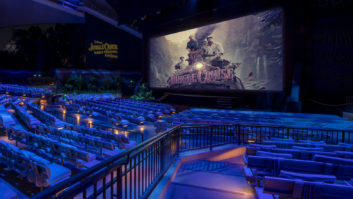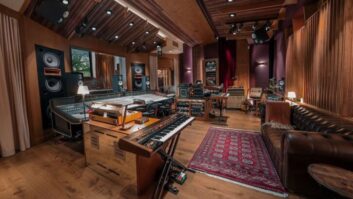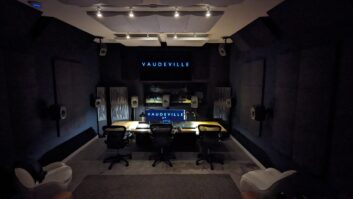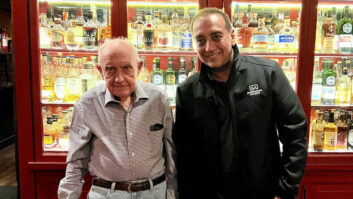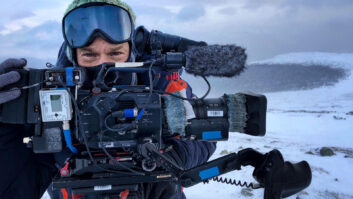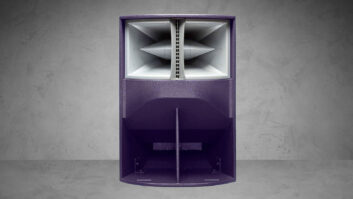Okay, kids, it’s the longest night of the year, so it’s time to gather ’round the simulated virtual fireplace and I’ll tell you some more stories from the bad old days, when I started out in this here recording business. It was 25 years ago this month when my girlfriend and I boarded a plane at JFK International Airport for Port of Spain, the capital of Trinidad and Tobago, for my first full-time gig as a recording engineer.
I was lucky, or perhaps unlucky, enough to start at the top. Unlike most of the folks you read about in this magazine, I didn’t break into the studio biz as the assistant ashtray-emptier at a great metropolitan studio, nor did I open my own little 8-track studio and record local bands at loss-leader prices until one of them signed with Columbia Records. No, my first studio job was as the manager and chief engineer of a beautiful, brand-new 24-track recording facility. The reason I got the gig was, well, because everyone else in New York had turned it down. They must have known something — either about the owners or about the joys of running a high-tech operation in the Third World — that I didn’t.
Actually, this story should have happened 25 years ago last month, but life in the Caribbean being what it is, we had to wait for things like a freight handler’s strike at the airport to be settled, and delays in getting work visas and import licenses for our household goods, all aggravated by phone service that was, to put it very politely, spotty.
At the time, the two-island nation boasted of having the highest per capita income in the English-speaking Caribbean, but that wasn’t saying much, as most of the population was still desperately poor. While the tiny Toboggoan economy was built on tourism, in Trinidad, where the studio was, there was little of that. Instead, there were oil refineries. Thanks to its proximity to Venezuela and harbors deep enough to handle transoceanic tankers, as well as a lack of government regulation in general, Trinidad was home to some very wealthy natives, most of whom had direct financial interest in the (foreign-owned) refineries. The rest of the populace lived in hope that the extreme levels of pollution they suffered would someday make them rich, too. In the meantime, many took advantage of the castoffs of the local industry and turned them into musical instruments: steel drums, which are, of course, made out of empty oil barrels.
The music scene was actually very exciting. Calypso, that superenergetic, irresistible dance form, was at its height, and reggae was making major inroads. A new type of Caribbean hybrid, soca, was gaining popularity, and local musicians, many of whom had spent time in New York or London, were beginning to understand how the modern recording studio could enhance their music. There was also a burgeoning film industry, at least according to the expatriate American filmmaker and his well-connected Trinidadian wife who had built the studio. They already had shot one feature film (something to do with lost cities of gold protected by Amazon women, which, according to the lead review on the Internet Movie Database, is “the worst movie I ever saw”) and were gearing up to do more. They also had plans for a record company, complete with pressing plant and a music publishing arm, and they had built the studio in hopes of attracting American and European artists who wanted a tropical experience but couldn’t afford George Martin’s recently opened Air Montserrat.
When we touched down in Port of Spain, my boss impressively had us waved through customs and took us to the apartment he’d found for us in a residential neighborhood upstairs from an elderly landlady. As is true in most countries that have suffered long periods under colonial rule, many Trinidadians adopted some of the more obnoxious attitudes of their English oppressors without really knowing why. In our landlady’s case, she had an impenetrable Victorian sense of decorum, which took the form of a prohibition on any music being played in her house. I spent an awful lot of time listening to music, and because my girlfriend was a pianist, this created a bit of a problem. To keep peace in the house, I agreed to play my stereo mostly through headphones, and somehow, a few weeks after we arrived, we convinced the landlady to let us rent an upright piano. But when the movers arrived and she was confronted with the actual instrument, she abruptly changed her mind and physically blocked them from coming up the stairs.
The boss found us another place, which we fell in love with right away. It was high on a hill above Port of Spain, with the most gorgeous view of the city, the glowing refinery towns beyond and the coast of South America beyond them. The sunsets, thanks to the high particulate content of the atmosphere, were spectacular. It was a building of 12 terraced apartments set into the hill, accessible only by a harrowing one-and-a-half-lane mountain road, which ended just above the top of the building. There was no landlady, but there were a pair of Canadian doctors, an oilfield worker from the U.S. (whose last job was in Iran), a young lawyer just back from school in England, a local automobile tire (or “tyre”) magnate and (rumor had it) the mistresses of several high government officials.
There was just one problem with the place: There was no water. The local water company wasn’t legally required to pump higher than a certain altitude, and our little aerie was at least 100 feet above that limit. So instead, the water arrived in huge trucks, and if someone happened to be around to pay off the driver (usually with rum), then maybe we’d see more water in a few days. But if not, it could be weeks.
Inevitably, some poor soul would get up in the morning one day when our tank had run dry, discover that he couldn’t take a shower and leave for work without bothering to close the tap. The water truck would arrive later that day and drop its load, and within a couple of hours, the entire tank would empty through our neighbor’s bathtub, onto his floor, out the living room and back down the hill from whence it came. And we would be without water, again.
My work life was like that too: occasional progress followed by major, often absurd, frustrations.
One of the first sessions I did was to record a steel band, the local equivalent of a symphony orchestra, for a single to be released just before Carnival, the annual Trinidadian pre-Lent bacchanalia that is rivaled in its over-the-topness only by Brazil’s. (I told another Carnival story in a Mix column a few years ago; you can find it at www.insideraudio.com.) The writer of the tune was a young man named Len “Boogsie” Sharpe, an absolute genius (and still very active today) at writing for an unusual ensemble that comprised two conga drums, a cowbell, brake drum, standard drum kit and some 30 players, each responsible for between one and four hand-hammered, hand-tuned, carefully matched steel drums.
Steel drums, or “pans,” are notoriously hard to record because the sound up close — which is a lot like banging on a tin can — is completely different from the sound at a distance, which can sometimes sound like an ethereal carillon crossed with a weird-overtoned pipe organ. The first time I got Boogsie in the studio for a solo recording, it took the whole session to figure out how to mike him: put him at one end of the room in the vocal sweet spot, then put a coincident pair of 414s in figure-8 mode as far away from him as possible.
The studio was in a huge concrete building with corrugated steel walls 40 feet high, surrounded by several acres of asphalt, which was surrounded by jungle. It was on the site of a U.S. Navy tracking station that had been built during World War II and given back to the local government in the 1970s. For the dozens of pans we were trying to record, there was only one solution: Go outside. We had a 150-foot, 24-channel snake for film work, so getting lines out the door was no problem.
The session was scheduled for late afternoon, as most of the players had day jobs. Boogsie drew up a plot of where the different sections (with names like “double tenors,” “guitar pans,” “cellos” and “quadrophonics”) should be. I marked it up with the mic model and cable numbers, handed it off to one of my eager new assistants and set off to find dinner.
An hour later, I came back to find the mics in place and the whole orchestra ready to go. The only problem was, the assistants had placed the band right up against one of the steel walls. We tried a take and the resulting slapback would have sent Sam Phillips running into the jungle. I asked the guys where they got the insane idea to put the pans so close to the building, and the owner stepped in and said he was the one who ordered it; the last time they recorded steel pans, they did it there. It was mono, for a film and “I kind of liked the echo.” Needless to say, the track was useless.
So for the next hour, we moved everyone 20 yards over and then reset the mics and the levels. By now, the sun was setting, and in that part of the world, the temperature and humidity can change very rapidly as day turns into night. We tried another take, and during the final fade, I started to hear strange popping sounds and then some shouting, first on one channel, then another, and within a few seconds on all 24 tracks. I rushed outside and found that the players (and my trusty assistants) had all dived inside the building or into their cars to take refuge — leaving two dozen brand-new AKGs, Shures, Electro-Voices and Neumanns to soak in the tropical downpour.
One more story. The studio had hired some local carpenters to build the control room furniture. They did some fine-looking work, but as most of their previous experience was in the domestic sphere, they were not terribly familiar with the concept of ventilation. The Dolby rack, for example, was built into a lovely hand-rubbed, completely sealed hardwood cabinet. By the time I was able to convince the boss to let me cut some holes in the back, we had lost several of the “Cat-22” channel cards. We wired the folks at Dolby UK, and they were very nice and promised to send us replacements right away.
Two months later, we were still waiting, while we tried to convince clients that they didn’t really need Dolby on all their tracks. Someone went downtown to the main customs office and found that, yes, the cards had arrived some time ago, but customs was waiting for us to give them a “classification.” (Our pointing out that they hadn’t bothered to notify us about this didn’t seem to impress them.) So the next day, I went down and explained that they were electronic subassemblies. Because we didn’t pay for them, they had no cash value and, therefore, we didn’t have to pay any duty. But there was no such category on their forms. Instead, I was asked whether they should be considered “electronic parts” or “electronic equipment,” the closest they could find.
“Call them parts,” I said. “But we make electronic parts in this country, and you cannot import anything that’s also made here without special dispensation,” came the reply. “You don’t have a license to import parts.” I had never heard of a parts factory in Trinidad — all I could think of was some poor soul filling transformer cans with waste oil in his bathtub — but I wasn’t going to argue. “Okay, then let’s call them ‘equipment,’” I said. “Ah!” came the swift rejoinder. “But then the equipment must have a cash value. And you must pay duty!”
I reached in my pocket and pulled out the first thing my fingers found: a $5 bill (worth about $2 U.S.). “How much cash value would this cover?” I demanded. The customs man dragged over a mechanical adding machine, and with great seriousness, punched in some numbers and pulled the crank. “At 17-percent duty, that would be $29.41,” he intoned. “$29.41 it is,” I said, leaving the five bucks on his desk and walking out with the cards.
I didn’t last too long in Trinidad. My boss, who had been a respected filmmaker, turned out to be a sleazebag and a bully. He bounced my paychecks, physically threatened me and tried to confiscate my passport. He recruited me with all sorts of promises to bring in foreign acts and promote the local music scene, but others later told me that wasn’t the idea at all: He was in reality building an international film and music bootlegging operation, for which the studio was a front.
After six months, I had had it, and I got out in a scene like the one at the end of The Year of Living Dangerously. Six months later, the place was liquidated. The equipment was scattered to the winds, the site was eventually leased to someone else and most of the projects I worked on never saw the light of day. I lost touch with everyone I had met there. My girlfriend and I stayed together a few more years, and then we went our separate ways, too. It left such an awful taste in my mouth, I wouldn’t go anywhere south of Florida for more than 10 years.
But now it’s 25 years later, and I have this strange hankering to go back. I want to see what became of the place and see how the recording scene in Trinidad has evolved. There were some beautiful places and lovely people there, and I would like to have a memory of them untarnished by the painful ones. I have some free time this month and a bunch of frequent-flyer miles burning a hole in my pocket. But this time, if I go, it’ll be on my own terms. I’ll let you know what happens.
Paul Lehrman is working on a lot of things, among them his tan.

